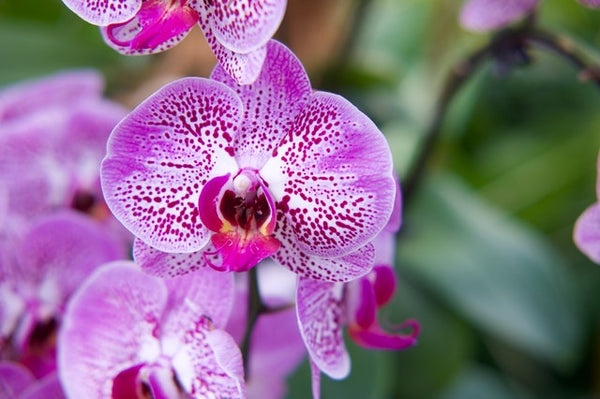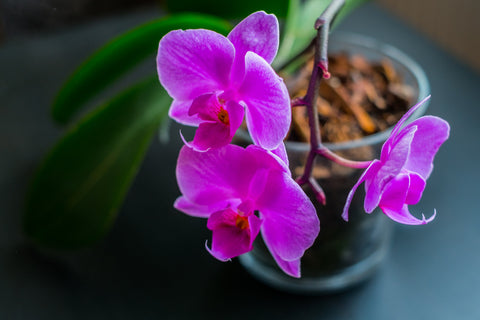Orchid plants have a reputation for being robust houseplants that demand a minimum amount of upkeep. With show-stopping flowers that last for many months, they’re arguably the most rewarding indoor plants, too.
Learn more about how to select the right type of orchids, how to water them sufficiently and with appropriate frequency, how to fertilize them timely, and generally, how to better take care of your orchids indoor.
Choosing Indoor Orchids for Your Home
You can’t expect a fish to survive on land or a bird to breathe underwater, right?
The same principle applies to indoor orchids. The secret to successfully growing orchids indoors lies in choosing the right type that can tolerate or thrive given the conditions of your home and your lifestyle, too.
Phalaenopsis Orchids

Cattleya Orchids
Dubbed as the queen orchid, Cattleyas are also fondly called as “corsage orchids,” because of women used to wear them as a fancy floral accessory for special events in previous times. Today these frilly, fuss-free, and fragrant blooms are one of our top-selling orchid plants that most clients love to have at home. Their flowers are large, showy, and come in a wide array of captivating colors, including purple to yellow, orange, red, green, and pink.
Cattleya orchid loves light but not directly. Put in a spot that gets ample amount of morning light, without getting burned. Somewhere near a south-facing window with sheer curtains would be nice.

Lady Slipper Orchids
Lady slipper has been used as a general term for all orchids with the interesting pouch on the lips, which belong to the Cypripedioideae subfamily. However, there are actually five genera of lady slipper orchids and not all are suited for growing indoors. Plus the fact that some of them are already considered a threatened species.

Dendrobium Orchids

Pansy Orchids
Cymbidium Orchids
Oncidium Orchids
Ludisia or Jewel Orchids
How to Water Your Indoor Orchids

As with any houseplant plant, knowing how to water your indoor orchids is essential. We’ve said it before and we’ll say it again: more plants have died of overwatering than underwatering. We’ll talk more about these two later.
According to Better Homes and Gardening, when it comes to watering indoor orchids, the manner and the frequency will vary greatly based on a variety of important factors, such as:
- The kind of orchids you have
- The type of pots your orchids are in
- The sort of orchid potting material used
- The temperature
- The humidity
- The light condition
Looking at these variables to consider, watering orchids may seem a bit complicated and daunting, especially for the budding orchid aficionado. But really, it’s not. Take note of these pointers and soon you’ll be taking care of your orchids like a pro.
The key to watering orchids is to get each particle of the potting material sufficient time to absorb the water. There are different watering techniques you can do, depending on where your orchids are planted.
If your orchid is potted in clay...
- Put your orchid pot in a bowl of water for 10 to 15 minutes.
- Make sure that the entire clay pot is submerged in water, with perhaps just an inch or two showing out.
- Lift it out and allow the excess water to drain thoroughly before returning your orchid plant to its usual spot.
Because clay is permeable, the water will be soaked by the walls of the pot and will be absorbed by the bark.
If your orchid is potted in plastic…
- Put the orchid plant in a shallow bowl that is empty.
- Slowly pour water into the bowl up to two inches deep.
- Let it sit for 10 to 15 minutes until the plant has fully absorbed the water.
- Take the orchid plant out of the bowl and allow it to drain the excess water before putting it back to its proper place.
In this second watering technique, we added the water slowly when the orchid plant was already in the bowl, as opposed to the first step where the bowl was already filled with water.
This is because, unlike clay, plastic pots cannot be penetrated by water. If you apply the first watering technique to an orchid plant in a plastic pot, chances are, the potting material will be pushed out and floating in the bowl in no time.
If your orchid is potted in a sphagnum moss or soilless mix…
Water thoroughly until it runs out of the drainage holes and saucer. Moss is quite good at holding water for a long time. It needs less watering compared to other orchid potting materials. Before watering again, poke it with your finger, at least, two inches down, to make sure that the moss is really dry inside.
How Often Do Indoor Orchids Need to Be Watered?
As a rule of thumb, indoor orchids require less watering than your outdoor orchids that get more light exposure.
- Drought-resistant orchids - This group includes cattleya orchids, oncidium orchids, and dendrobium orchids. These orchids would thrive excellently when watered every seven days.
- Other types of orchids - Water every four to five days. This recommendation goes to pansy orchids, lady slipper orchids, and phragmipedium.
Check Your Soil/Potting Mix:
Don’t forget to do a soil check first between each watering session of your orchids.
Stick a pencil or your finger into the potting mix to check if it’s completely dried before watering again. Water more frequently during hot summer months or high humidity, as orchid plants would dry out faster during this time.
How to Tell If You Are Over-Watering or Under-Watering Your Orchids

Over-watered Orchids
Over-watering happens when the root of your orchid plant is wet all the time, which leads to the dreaded root rot.
Here are some tell-tale signs that you are overwatering your orchids:
- Roots are dark, mushy, and probably rotten.
- Leaves are floppy, wilting, rotting, with undesirable growths underneath.
- Overall, over-watered orchids look weak, wet, and rotten.
If you feel you are guilty of over-watering your precious orchid plant, don’t lose hope. There may still be a chance to save it.
Here’s what you can do:
- Take the orchid plant out of its pot immediately.
- Cut out damaged roots and repot.
- Choose an optimal orchid potting mix that’ll offer better drainage.
- Place your orchid in a spot that gets warm, bright but indirect light.
- Space out your watering sessions longer.
Under-watered Orchids
While many orchid owners know better than to overwater their orchid plants, under-watering is not unheard of, too. That can be just as bad, especially for drought-resistant orchids.
Watch out for these under-watering symptoms:
- Roots are thin, dry, shriveled, and may crack when touched.
- Leaves are yellow, shrunken, and may have ugly spots.
- The potting material is packed hard, parched dry.
- Under-watered orchids are usually stunted, ugly, and missing the good qualities of a healthy orchid plant.
Salvaging an under-watered orchid plant may relatively be easier.
- Check the root health by removing the orchid plant out of its pot.
- Cut off all dead roots.
- Repot the orchid plant in a potting mix that holds more water.
- Increase the watering frequency.
Should I Water My Orchid With Ice Cubes?

The answer to this is NO.
We hate to break it to you, but watering your orchids, or any houseplant for that matter, will only do them more harm than good. Here’s why.
“The idea of putting ice on orchids seems very counterintuitive. After all, Phalaenopsis orchids, the main orchid being promoted to enjoy ice-water culture, are from Southeast Asia – an area that has probably not seen ice since the last Ice Age,” the Oregon Orchid Society explains.
The Truth About Ice Cubes Orchids
FACT: The healthy humidity your orchids need to thrive beautifully is not achieved by just throwing few ice cubes every now and then.
Store-bought orchids are prone to overwatering because of two reasons:
- Pots with poor drainage
- Inappropriate potting compound
More often than not, the orchids that you get from flower shop, which advocate the ice cube watering method sell low-cost, mass-produced orchid plants that come in cheap pots with no efficient drainage and dense moss.
With this combination, it’s easy for the potting compound to be soggy and lead to decayed roots even with a meager amount of watering.
Is Your Orchid Getting Enough Light?
To make sure it’s getting enough sunlight minus the damage, always shield your orchid plants from direct sun exposure.
Sheer curtains are good sunblocks for indoor orchids while still allowing for a little beneficial sunlight to come in for orchid plants near windows. Place them under shady trees or roofed areas if they're outdoors.
Keep your orchid plants away from heat sources, such as heaters, ovens, stoves, or fireplaces, too.
Source:


My orchid has not bloomed in a couple of years although the leaves look healthy and continue to grow. There are long greenish somethings with a rounded end growing up instead. Is this where the bloom should bloom from? If so what do I need to do to help it bloom?
Hello! Thanks, Bill!
Attractive straight forward site.
Thank you.
Bill
Leave a comment